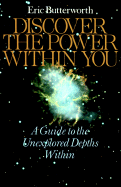
Ernest Holmes, founder of the Church of Religious Science and all-round California legend, was a prolific writer. Indeed, Holmes seems to have been an overachiever on almost every front - he was a tireless preacher and self-promoter and established a religious empire which continues to have an affect on contemporary popular culture. Of course, his magnum opus The Science of Mind is a book I've been reading slowly all year and blogging along the way. This Thing Called You is a much smaller work, a slim book made up mainly of affirmations, meditations and prayer treatments intended to improve the reader's life and strengthen her sense of living spiritually.
And where The Science of Mind, a vast book in every sense, tends toward the wordy and prolix, this smaller book is actually quite elegant and sparse, setting out in simple language Holmes' own views on how exactly the Universe (not my capital "U") functions. Indeed, it is a terrific read at times, inspiring and thoughtful, providing a very clear and practical path of spiritual practice.
In every piece of Holmes' writing that I have read thus far it is clear that his philosophy owes a debt primarily to Emerson and Mary Baker Eddy (though probably through the medium of her student and later rival Emma Curtis Hopkins). Indeed, he is free in his references to Emerson, as are most New Thought writers. He is less forthcoming in his recognition of the guiding hand of Eddy - if she is mentioned at all it is in elliptical and disapproving references.
The book's primary theme is, as always, that each of us represents the Universe in its entirety, that, to quote Emerson (as Holmes does) "...every man is a doorway to the inifinite." This infinitude which we represent (and which we are, at the most basic level) needs only to be awakened to. We need not go on any spiritual search, says Holmes, because:
"...the thing you are after is already here, within you. The only things that stand between you and it are the accumulated thoughts, beliefs and emotions of the ages" (p.13).
More than a slight impediment, one would imagine, but Holmes is eternally optimistic that the human is moving ever forward (or should that be inward) toward full knowing of her own divinity. Holmes says that the problem of our future lies not in being selfish or unfairly possessed of good fortune. The real problem is that we do not wish for more and better for ourselves and others. Our wishes, desires and thoughts create our own reality, and so communal ideas (memes, I suppose we'd call them now) are merely these same false constructs writ large. Poverty and suffering exist only because we continue to acknowledge their reality. All that is good and perfect already exists - is, in fact, all that is real - we have simply failed to arrange the world and our lives in the correct way. Holmes advocates not revolution, but the rearrangement of mental furniture (p.17).
We encounter exactly those things we imagine, says Holmes, "If you believe that wherever you go you will meet with love and friendship, with appreciation and gratitude, then this will become...your law" (p. 18). This is, of course, a classic New Thought assertion, and it also speaks of exactly the sort of folk wisdom common not only to early twentieth century Americans, but to most of us now. Common sense and theological assertion, however, do not make for much of a scientific case, and those more cynically minded might be happy to point towards plenty of examples of the gullible and the kind meeting sticky ends, despite their best feelings.
But Holmes would stand his ground, I imagine, and in this book brooks no oppositional voice, nor even raises the spectre of an alternative (and much less comforting) viewpoint. For the practitioner of Science of Mind, as for all of the early exponents of New Thought, it is the matter of belief which shapes our physical world, our mental universe, and the reality we continue to experience. It may be cold comfort, but for the experiencer of misfotune, harrassment or slander, Holmes' has simple and constant advice:
"...everything in your life depends on belief...it is done unto you as you believe. Change your belief and you can change your world" (p. 25).



















